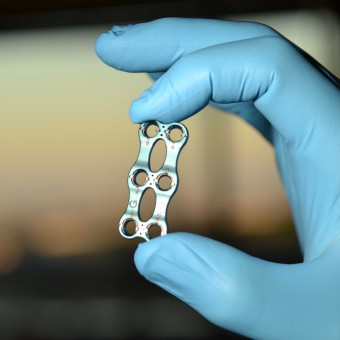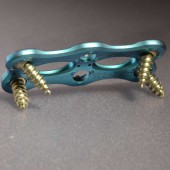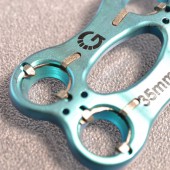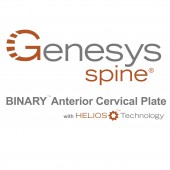Binary® Anterior Cervical Plating System by J. Landon Gilkey |
Home > Winners > #42462 |
 |
|
||||
| DESIGN DETAILS | |||||
| DESIGN NAME: Binary® PRIMARY FUNCTION: Anterior Cervical Plating System INSPIRATION: The design intent was to have an implant with maximum screw articulation while maintaining a robust locking feature. Articulation is an important factor in placing a cervical plate. If a plate does not have enough articulation, the plate must be placed higher on the cervical spine in order to maintain enough bone purchase to follow the natural angle of the cervical anatomy. Studies show that the more intrusive the plate is on the vertebra, the greater the chance of adjacent-level ossification. UNIQUE PROPERTIES / PROJECT DESCRIPTION: The Binary® Anterior Cervical Plating (ACP) System is an implant used to stabilize the cervical spine during the development of a solid spinal fusion. The Plating System incorporates patented Helios Technology from Genesys Spine, which is a combination of counter rotation functionality, anti-backout functionality, and what is called the "Zero-Step" OPERATION / FLOW / INTERACTION: In a continued effort to reduce patient pain, improve their surgical outcomes and minimize recovery time, the Binary plate was designed to assist the surgeon with ease of optimal placement, reduction of both short and long-term complications and reduced surgical steps. As a result, patients may benefit from: - reduced surgical time and exposure to anesthesia; - reduced interoperative exposure due to less instruments being required during surgery; - the potential for reduced fluorosopy exposure; - reduced risk of dysphagia and: - reduced risk of adjacent-level ossification development PROJECT DURATION AND LOCATION: The duration of this project from concept to commercialization was 14 months. The initiation of the project started in May 2013 and completed July 2014. Within that time frame, there were several test prototypes, required mechanical testing for life long fatigue strength as well as surgeon evaluation. All of the design work, testing and evaluations were conducted in Austin, Texas. FITS BEST INTO CATEGORY: Medical Devices and Medical Equipment Design |
PRODUCTION / REALIZATION TECHNOLOGY: This particular design came from clinical feedback of the previously marketed Genesys Spine Cervical Plate. During surgery, the physician were trying to get a higher angulation of the screw trajectory to prevent adjacent level ossification. The Binary plate provides the required angulation while maintaining the one step lock feature. The audible, tactile, and visual feedback was derived from the use of common ratcheting tools. This lock concept allowed the surgeon to perform the surgery without the need for extra steps. SPECIFICATIONS / TECHNICAL PROPERTIES: Offering plate sizes from 1 level to 4 levels, the Genesys Spine® Binary® Anterior Cervical Plate has a smooth low-profile design incorporating lordotic curvature to minimize plate contouring during the procedure. The Binary Plate provides self-drilling, self-tapping 3.75mm primary and 4.25mm recovery screws in both fixed and variable options. Variable screws allow for up to 47 degrees cephalad-caudad and up to 27-degree medial-lateral articulation. SCREW DIAMETER SCREW LENGTHS 3.75 and 4.25mm 10mm 3.75 and 4.25mm 12mm 3.75 and 4.25mm 14mm 3.75 and 4.25mm 16mm 3.75 and 4.25mm 18mm TAGS: medical, device, cervical, lock, Binary, plate, surgery RESEARCH ABSTRACT: In a continued effort to reduce patient pain, improve their surgical outcomes and minimize recovery time, the BINARY plate was designed to assist the surgeon with ease of optimal placement, reduction of both short and long-term complications and reduced surgical steps. The data collected to create this plate was to design a plate that: - reduced surgical time and exposure to anesthesia; - reduced interoperative exposure due to less instruments being required during surgery; - the potential for reduced fluorosopy exposure; - reduced risk of dysphagia and: - reduced risk of adjacent-level ossification development The team created a unique locking mechanism out of a Ultra-Elastic metal (Nitinol). This material allows for elongation without deformation. Additionally, it is very strong and biocompatible. By creating pockets in a titanium plate, the nitinol lock could slip in and maintain its position. The plates had to undergo a 5 million cyclic load to show that a lifetime of movement would not deform, break, or defeat the assembly. Once the team was satisfied with the mechanical strength of the system, the surgeon and end user were asked to evaluate the ease of use and the clinical effectiveness. The results of the prototyping, testing, and evaluation were very strong. The Binary Plate removes the guess work for the surgeons. One step means the patients will spend less time in surgery and will be exposed to much less risk. CHALLENGE: The most technically challenging aspect of this plate was to maintain the high articulation without creating a thicker plate. Since cervical plates lay underneath the esophagus, thickness can lead to clinical issues. Having a thin plate reduces the amount of irritation, however, thinner plates typically do not have room to place a lock or allow for greater angulation of the screws. The Binary plate finds the harmony of required angulation with an integrated lock that does not add to the plate profile. ADDED DATE: 2015-09-02 19:55:25 TEAM MEMBERS (13) : Inventors Names:, Josh Kaufmann, Scott Bryant, Greg Calbert, Brian Bergeron, Landon Gilkey, John Stokes, M.D., Matthew Geck, M.D., , Engineers Names:, James “Landon” Gilkey, Benjamin Keller and Brian J. Bergeron IMAGE CREDITS: J. Landon Gilkey, 2015. PATENTS/COPYRIGHTS: U.S. Patent Nos. 8,784,459 and 9,119,681 |
||||
| Visit the following page to learn more: http://genesysspine.wpengine.com/product |
|||||
| AWARD DETAILS | |
 |
Binary® Anterior Cervical Plating System by J. Landon Gilkey is Winner in Medical Devices and Medical Equipment Design Category, 2015 - 2016.· Read the interview with designer J. Landon Gilkey for design Binary® here.· Press Members: Login or Register to request an exclusive interview with J. Landon Gilkey. · Click here to register inorder to view the profile and other works by J. Landon Gilkey. |
| SOCIAL |
| + Add to Likes / Favorites | Send to My Email | Comment | Testimonials | View Press-Release | Press Kit |
Did you like J. Landon Gilkey's Medical Product Design?
You will most likely enjoy other award winning medical product design as well.
Click here to view more Award Winning Medical Product Design.








